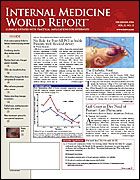Publication
Article
Internal Medicine World Report
Thiazolidinediones also Act on the Liver as Primary Target
Author(s):
New Data Establish Their Expanded Role beyond Adipose Tissue
Diabetes Care
The known antidiabetes effects of thiazolidinediones (TZDs) are the result of these agents binding to and activating peroxisome-pro-liferator?activated receptor (PPAR)Υ, which is predominantly found in adipose or fat tissue. For the first time, a study has shown that TZDs also affect the PPARΥ in liver (. 2006; 29:2275-2281).
An ongoing controversy, accompanied by a dearth of solid research, involves the effects of TZDs on organs such as the liver, pancreas, heart, spleen, and muscle?all of which also express PPARΥ. Earlier researchers agreed that TZDs improve hepatic insulin sensitivity, but their findings often conflicted, with some, for example, showing that TZDs reduce endogenous glucose production and others demonstrating no effects on the production of endogenous glucose.
When all the previous study results are "taken together with the current results, these findings indicate that liver is an important primary target of TZD action," contend the investigators of the new study, led by Amalia Gastaldelli, PhD, of the University of Texas Health Science Center, San Antonio.
A total of 20 patients with type 2 diabetes who were already receiving a sulfonylurea were randomized in the study to 4 months of treatment with pioglitazone (Actos) 45 mg/day or placebo. Effects on the liver were assessed with baseline and posttreatment measurements of adiponectin (an adipocyte-derived cytokine that enhances peripheral and insulin sensitivity), endogenous glucose production, gluconeogenesis (ie, the biosynthesis of new glucose in the liver), and insulin sensitivity (using the 2-step hyperinsulinemic-euglycemic clamp [240 and 960 pmol/min per m2]).
As expected, at the end of 16 weeks of treatment, the fasting plasma glucose and hemoglobin A1c levels decreased in the pioglitazone group and increased in the placebo group. But fasting plasma adiponectin concentrations also increased significantly in the pioglitazone group, from 7.6 μg/mL at baseline to 17.6 μg/mL posttreatment. Changes in circulating adiponectin were inversely correlated with changes in all of the following catagories:
? Fasting plasma glucose concentrations
? Residual endogenous glucose production during 240 pmol/min per m2 clamp
? Gluconeogenic flux (calculated by multiplying percent gluconeogenesis by endogenous glucose production).
In addition, increases in plasma adiponectin with pioglitazone positively correlated with changes in total body glucose disposal. These effects led the investigators to speculate that adiponectin may be the insulin-sensitizing coordinator that oversees the "cross-talk between adipose tissue, muscle, and liver."
Stepwise regression analysis identified changes in gluconeogenesis flux as the strongest determinant of changes in fasting plasma glucose. However, the investigators note, while the pioglitazone group showed a significant decline in fasting glucose concentration (average, ?2.3 mmol/L), it did not demonstrate a significant decrease in hepatic glucose output. Instead, the decrease in glucose production was deemed to be partially offset by a small increase in the breakdown of glycogen into glucose molecules, in other words, hepatic autoregulation.
J Clin Endocrinol Metab
Noting that their results are similar to those of another study, in which drug-na?ve patients with type 2 diabetes were treated with the other TZD, rosiglitazone (Avandia; . 2006; 91:806-812), the investigators conclude that the efficacy of TZDs can be attributed to 4 specific actions:
? Improved hepatic insulin sensitivity during the postabsorptive state, leading to reduced glucose production in the liver
? Improved muscle insulin sensitivity under conditions of hyperinsulinemia, leading to increased tissue glucose uptake
? Improved adipose tissue insulin sensitivity, which inhibits the release of free fatty acid
? Increased circulating adiponectin.






